Variations in the Concentration of Magnetic Minerals and Heavy Metals in Suspended Sediments from Citarum River and Its Tributaries, West Java, Indonesia
Abstract
:1. Introduction
2. Materials and Methods
2.1. Description of the Research Area
2.2. Collection and Analysis of Samples
3. Results and Discussion
3.1. Results
3.2. Discussion
4. Conclusions
Acknowledgments
Author Contributions
Conflicts of Interest
References
- Kapička, A.; Petrovský, E.; Ustjakb, S.; Machackova, K. Proxy mapping of fly-ash pollution of soils around a coal-burning power plant: A case study in the Czech Republic. J. Geochem. Explor. 1999, 66, 291–297. [Google Scholar] [CrossRef]
- Hoffmann, V.; Knab, M.; Appel, E. Magnetic susceptibility mapping of roadside pollution. J. Geochem. Explor. 1999, 66, 313–326. [Google Scholar] [CrossRef]
- Petrovský, E.; Kapička, A.; Jordanova, N.; Knab, M.; Hoffmann, V. Low-field magnetic susceptibility: A proxy method of estimating increased pollution of different environmental systems. Environ. Geol. 2000, 39, 312–318. [Google Scholar]
- Gautam, P.; Blaha, U.; Appel, E.; Neupane, G. Environmental magnetic approach towards the quantification of pollution in Kathmandu urban area, Nepal. Phys. Chem. Earth 2004, 29, 973–984. [Google Scholar] [CrossRef]
- Desenfant, F.; Petrovský, E.; Rochette, P. Magnetic signature of industrial pollution of stream sediments and correlation with heavy metals: Case study from South France. Water Air Soil Poll. 2004, 152, 297–312. [Google Scholar] [CrossRef]
- Blaha, U.; Appel, E.; Stanjek, H. Determination of anthropogenic boundary depth in industrially polluted soil and semi-quantification of heavy metal loads a using magnetic susceptibility. Environ. Pollut. 2008, 156, 278–289. [Google Scholar] [CrossRef] [PubMed]
- Zhang, C.X.; Huang, B.C.; Piper, J.D.A.; Luo, R.S. Biomonitoring of atmospheric particulate matter using magnetic properties of Salix matsudana tree ring cores. Sci. Total Environ. 2008, 393, 177–190. [Google Scholar] [CrossRef] [PubMed]
- Zhang, C.; Qiao, Q.; Piper, J.D.A.; Huang, B. Assessment of heavy metal pollution from a Fe-smelting plant in urban river sediments using environmental magnetic and geochemical methods. Environ. Pollut. 2011, 159, 3057–3070. [Google Scholar] [CrossRef] [PubMed]
- Bilinski, F.S.; Bilinski, H.; Tibljas, D.; Scholger, R. Magnetic, geochemical and mineralogical properties of sediments from karstic and flysch rivers of Croatia and Slovenia. Environm. Earth Sci. 2014, 72, 3939–3953. [Google Scholar] [CrossRef]
- Jordanova, D.; Veneva, L.; Hoffmann, V. Magnetic susceptibility screening of of anthropogenic impact on the Danube river sediment in northwestern Bulgaria—Preliminary results. Stud. Geophys. Geod. 2003, 47, 403–418. [Google Scholar] [CrossRef]
- Franke, C.; Kissel, C.; Robin, E.; Bontè, P.; Lagroix, F. Magnetic particle characterization in the Seine river system: Implications for the determination of natural versus anthropogenic input. Geochem. Geophy. Geosy. 2009, 10, Q08Z05. [Google Scholar] [CrossRef]
- Schmidt, A.; Yarnold, R.; Hill, M.; Ashmore, M. Magnetic Susceptibility as proxy for heavy metal pollution: A site study. J. Geochem. Explor. 2005, 85, 109–117. [Google Scholar] [CrossRef]
- Lu, S.G.; Bai, S.Q. Study on the correlation of magnetic properties and heavy metals content in urban soils of Hangzhou City, China. J. Appl. Geophys. 2006, 60, 1–12. [Google Scholar] [CrossRef]
- Zhang, C.; Appel, E.; Qiao, Q. Heavy metal pollution in farmland irrigated with river water near a steel plant—Magnetic and geochemical signature. Geophys. J. Int. 2013, 192, 963–974. [Google Scholar] [CrossRef]
- Dlouha, S.; Petrovský, E.; Kapička, A.; Boruvka, L.; Ash, C.; Drabek, O. Investigation of Polluted Alluvial Soils by Magnetic Susceptibility Methods: A Case Study of the Litavka River. Soil Water Res. 2013, 4, 151–157. [Google Scholar]
- Xu, Y.; Sun, Q.; Yi, L.; Yin, X.; Wang, A.; Li, Y.; Chen, J. The source of natural and anthropogenic heavy metals in the sediments of the Minjiang River Estuary (SE China): Implications for historical pollution. Sci. Total Environ. 2014, 493, 729–736. [Google Scholar] [CrossRef] [PubMed]
- BAPPENAS. Atlas Citarum 2011. In Integrated Citarum Water Resources Management Investment Program (ICWRMIP); National Development Planning Agency (BAPPENAS): Jakarta, Indonesia, 2011; p. 1. [Google Scholar]
- Chanpiwat, P.; Sthiannopkao, S. Status of metal levels and their potential sources of contamination in Southeast Asian rivers. Environ. Sci. Pollut. Res. 2014, 21, 220–233. [Google Scholar] [CrossRef] [PubMed]
- Hutasoit, L. Groundwater Surface Conditions with and without Permeation Artificial in Bandung: Numerical Simulation Results. J. Geol. Indonesia 2009, 4, 177–188. [Google Scholar]
- Climate-Data.Org. Available online: https://en.climate-data.org/location/607890/ (accessed on 14 July 2017).
- Hidayat, Y.; Murtilaksono, K.; Wahjunie, E.D.; Panuju, D.R. The characteristics of river discharge of Citarum Hulu. J. Ilmu Pertanian Indonesia 2013, 18, 109–114. [Google Scholar]
- Lu, S.; Yu, X.; Chen, Y. Magnetic properties, microstructure and mineralogical phase of technogenic magnetic particles (TMPs) in urban soils: Their sourceidentification and environmental implications. Sci. Total Environ. 2016, 543, 239–247. [Google Scholar] [CrossRef] [PubMed]
- Bijaksana, S.; Huliselan, E.K. Magnetic properties and heavy metal content of sanitary leachate sludge in two landfill sites near Bandung, Indonesia. Environ. Earth Sci. 2010, 60, 409–419. [Google Scholar] [CrossRef]
- Thompson, R.; Oldfield, F. Environmental Magnetism; Allen and Unwin Publishers Ltd.: London, UK, 1986; p. 227. [Google Scholar]
- Evans, M.E.; Heller, F. Environmental Magnetism Principles and Applications of Enviromagnetics; Academic Press: Cambridge, MA, USA, 2003; p. 147. [Google Scholar]
- Dearing, J.A. Environmental Magnetic Susceptibility: Using the Bartington MS2 System; Chi Publishing: Kenilworth, UK, 1994; p. 54. [Google Scholar]
- Knab, M.; Hoffmann, V.; Petrovský, E.; Kapička, A.; Jordanova, N.; Appel, E. Surveying the anthropogenic impact of the Moldau river sediments and nearby soils using magnetic susceptibility. Environ. Geol. 2006, 49, 527–535. [Google Scholar] [CrossRef]
- Chaparro, M.A.E.; Suresh, G.; Chaparro, M.A.E.; Sinito, A.M.; Ramasamy, V. Magnetic studies and elemental analysis of river sediments: A case study from the Ponnaiyar River (Southeastern India). Environ. Earth Sci. 2013, 70, 201–213. [Google Scholar] [CrossRef]
- Chaparro, M.A.E.; Sinito, A.M.; Ramasamy, V.; Marinelli, C.; Chaparro, M.A.E.; Mullainathan, S.; Murugesan, S. Magnetic measurements and pollutants of sediments from Cauvery and Palaru River, India. Environ. Geol. 2008, 56, 425–437. [Google Scholar] [CrossRef]
- Ubangoh, R.U.; Pacca, I.G.; Nyobe, J.B.; Hell, J.; Ateba, B. Petromagnetic characteristics of Cameroon Line volcanic rocks. J. Volcanol. Geoth. Res. 2005, 142, 225–241. [Google Scholar] [CrossRef]
- Peters, C.; Dekkers, M.J. Selected room temperature magnetic parameters as a function of mineralogy, concentration and grain size. Phys. Chem. Earth 2003, 28, 659–667. [Google Scholar] [CrossRef]
- Chaparro, M.A.E.; Krishnamoorthy, N.; Chaparro, M.A.E.; Lecomte, K.L.; Mullainathan, S.; Mehra, R.; Sinito, A.M. Magnetic, chemical and radionuclide studies of river sediments and their variation with different physiographic regions of Bharathapuzha River, southwestern India. Stud. Geophys. Geod. 2015, 59, 438–460. [Google Scholar] [CrossRef]
- Jordanova, D.; Hoffmann, V.; Fehr, K.T. Mineral magnetic characterization of anthropogenic magnetic phases in the Danube river sediments (Bulgarian part). Earth Planet Sci. Lett. 2004, 221, 71–89. [Google Scholar] [CrossRef]
- Chaparro, M.A.E.; Rajkumar, P.; Chaparro, M.A.E.; Ramasamy, V.; Sinito, A.M. Magnetic parameters, trace elements, and multivariate statistical studies of river sediments from southeastern India: A case study from the Vellar River. Environ. Earth Sci. 2011, 63, 297–310. [Google Scholar] [CrossRef]
- Consensus-Based Sediment Quality Guidelines Recommendations. Available online: http://dnr.wi.gov/topic/brownfields/documents/cbsqg_interim_final.pdf (accessed on 19 April 2017).
- Persaud, D.; Jaagumagi, R.; Hayton, A. Guideline for the Protection and Management of Aquatic Sediment Quality in Ontario; Ministry of Environment and Energy: Toronto, ON, Canada, 1993; p. 3.
- Canadian Sediment Quality Guidelines for the Protection of Aquatic Life. Available online: https://www.pla.co.uk/Environment/Canadian-Sediment-Quality-Guidelines-for-the-Protection-of-Aquatic-Life (accessed on 19 April 2017).
- Sediment Protective Concentration Levels (PCLs). 2006. Available online: http://www.tceq.texas.gov/assets/public/remediation/trrp/sedpcls_2006.pdf (accessed on 19 May 2017).
- Dunlop, D.J. Theory and application of the Day plot (Mrs/Ms versus Hcr/Hc): Application to data for rocks, sediments and soils. J. Geophys. Res. 2002, 107, 1–15. [Google Scholar]
- Bibi, M.H.; Ahmed, F.; Ishiga, H. Assessment of metal concentrations in lake sediments of southwest Japan based on sediment quality guidelines. Environ. Geol. 2007, 52, 625–639. [Google Scholar] [CrossRef]
- Paramasivam, K.; Ramasamy, V.; Suresh, G. Impact of sediment characteristics on the heavy metal concentration and their ecological risk level of surface sediments of Vaigai river, Tamilnadu, India. Spectrochim. Acta Part A 2015, 137, 397–407. [Google Scholar] [CrossRef] [PubMed]
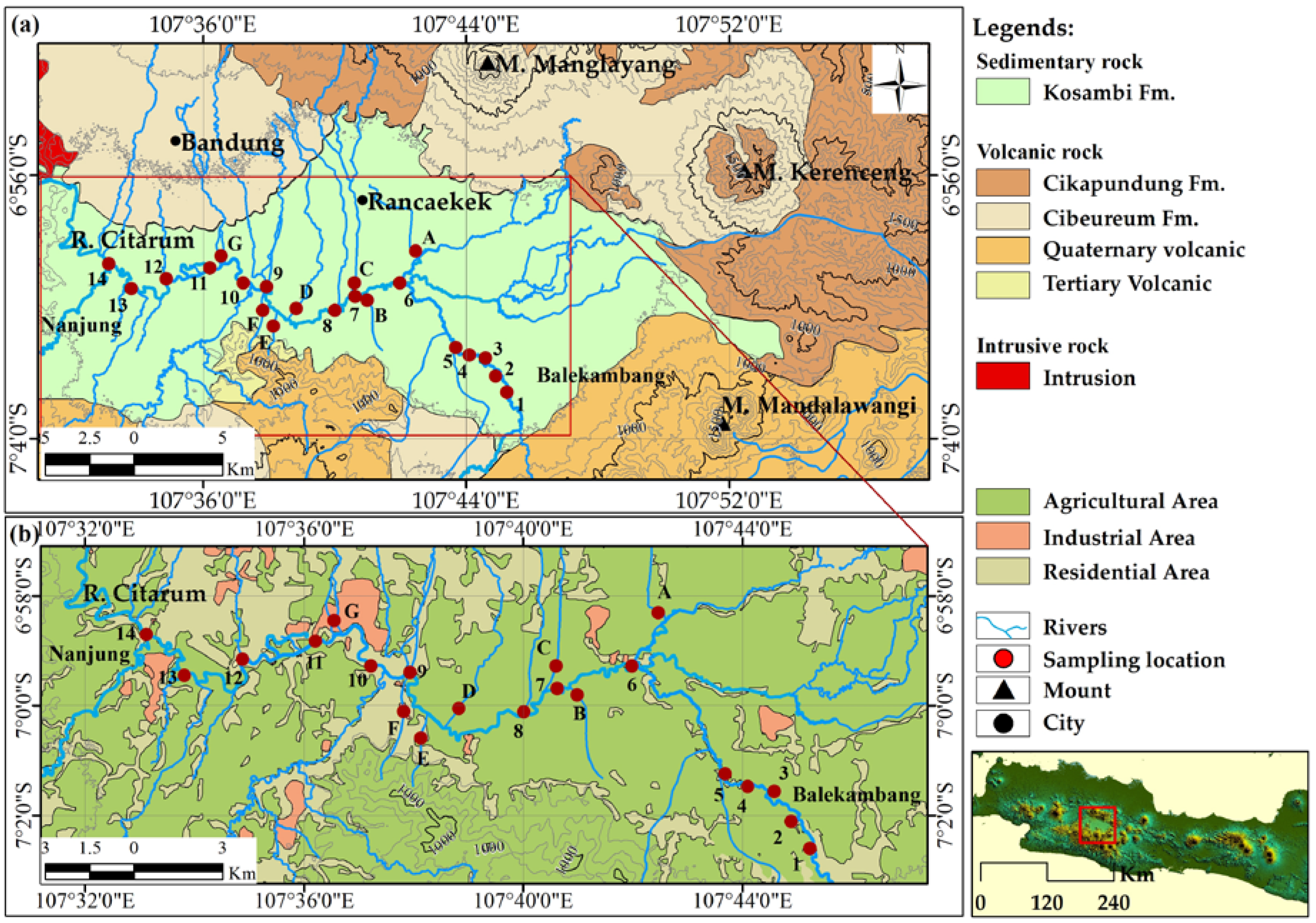
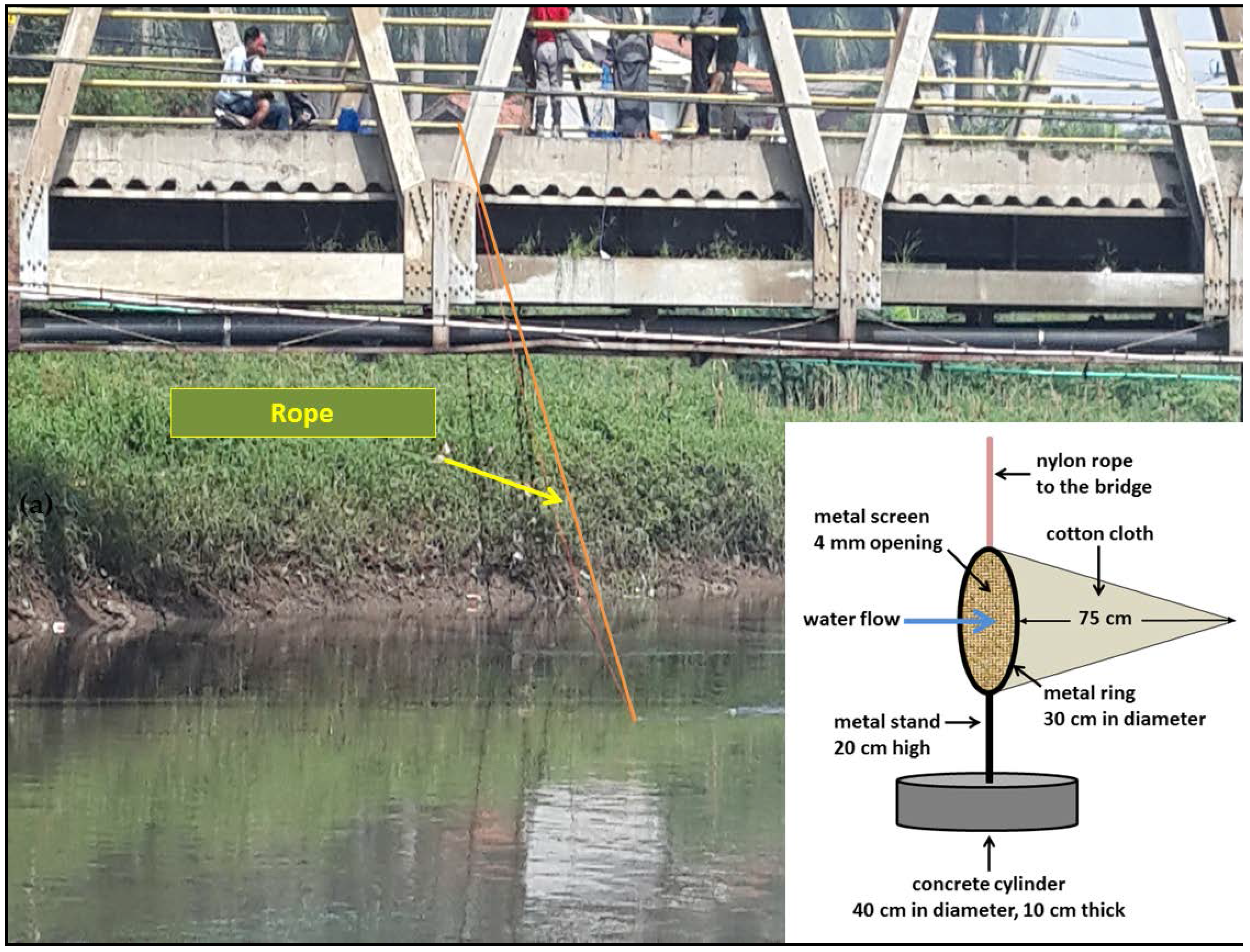
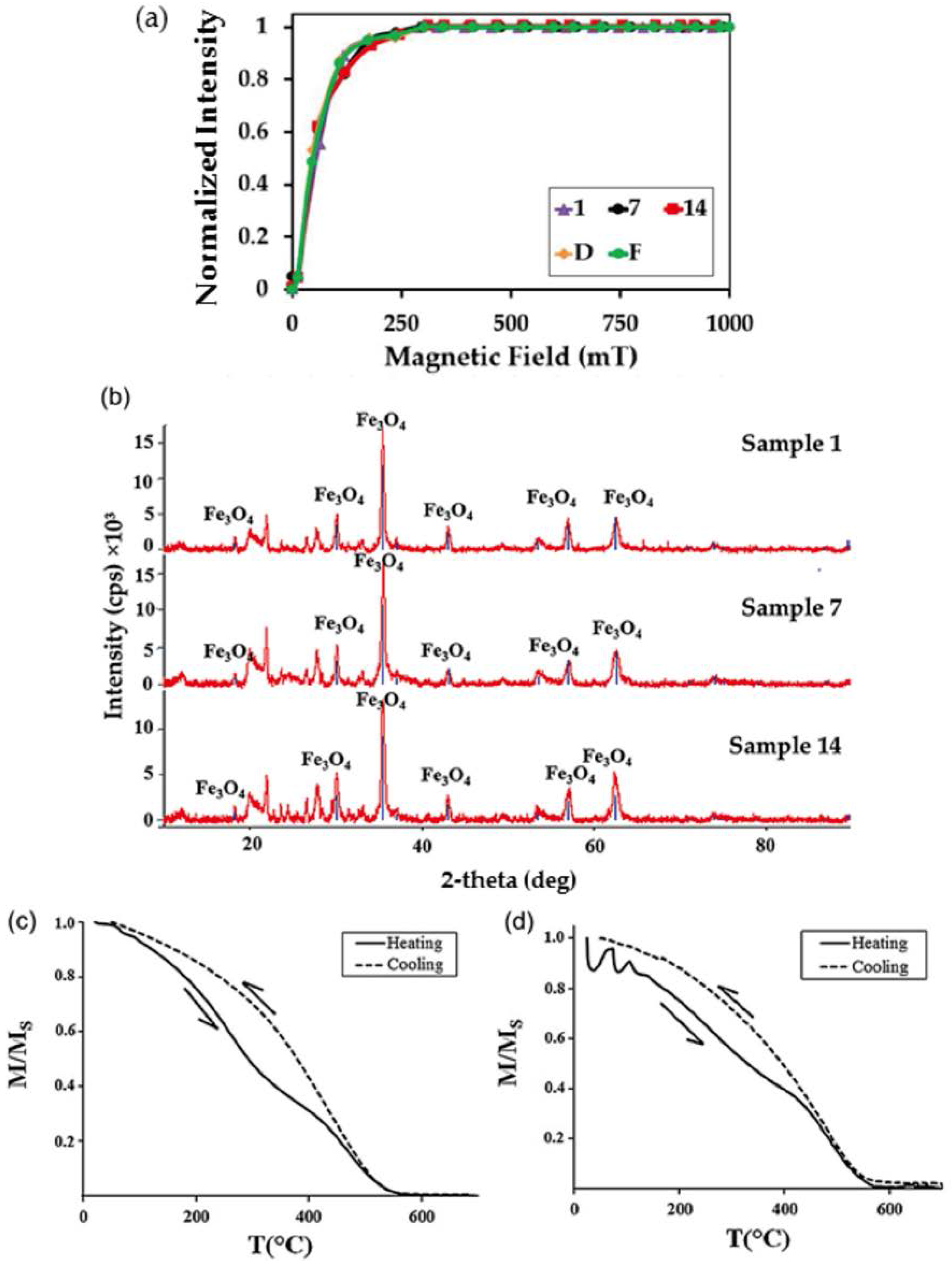
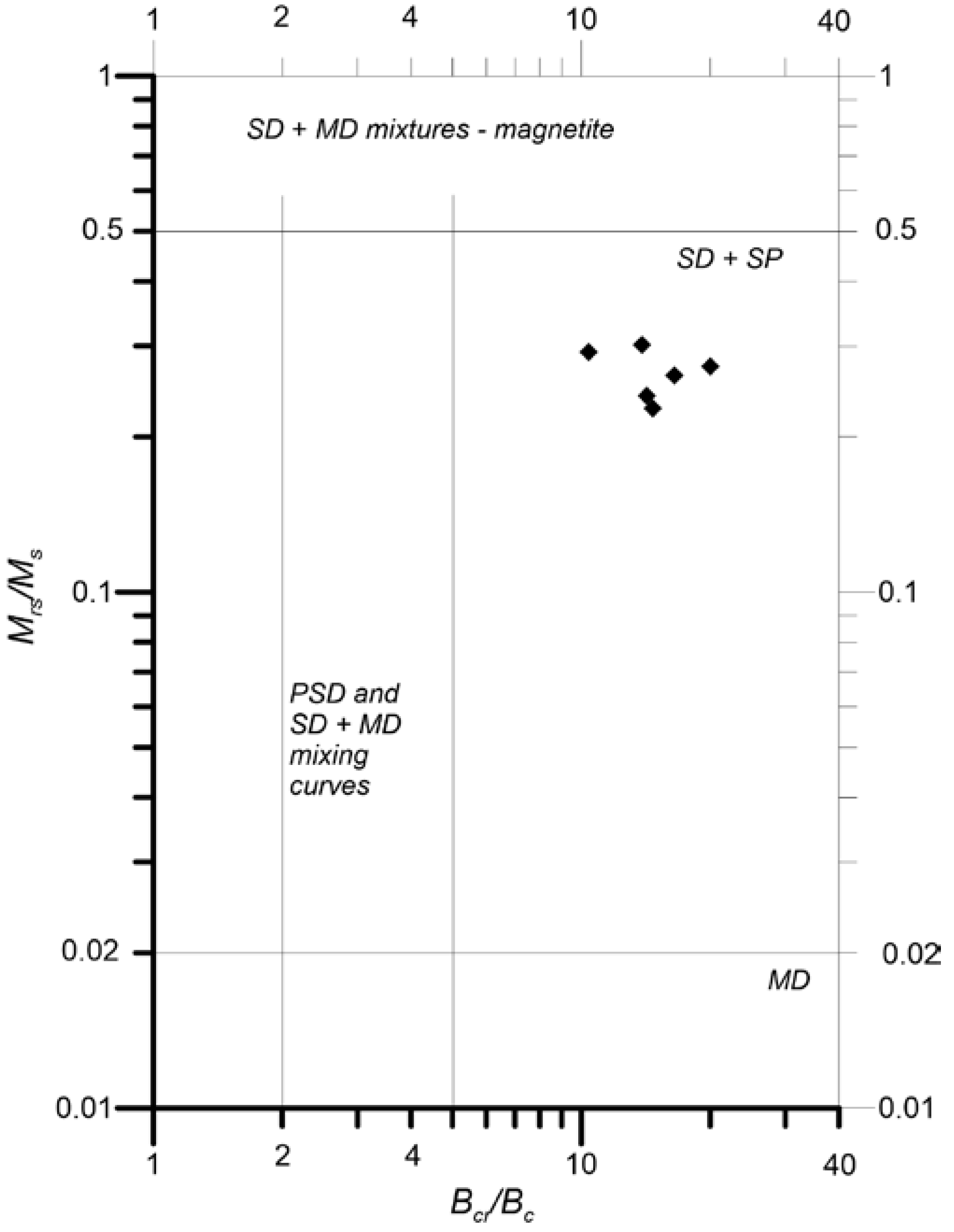
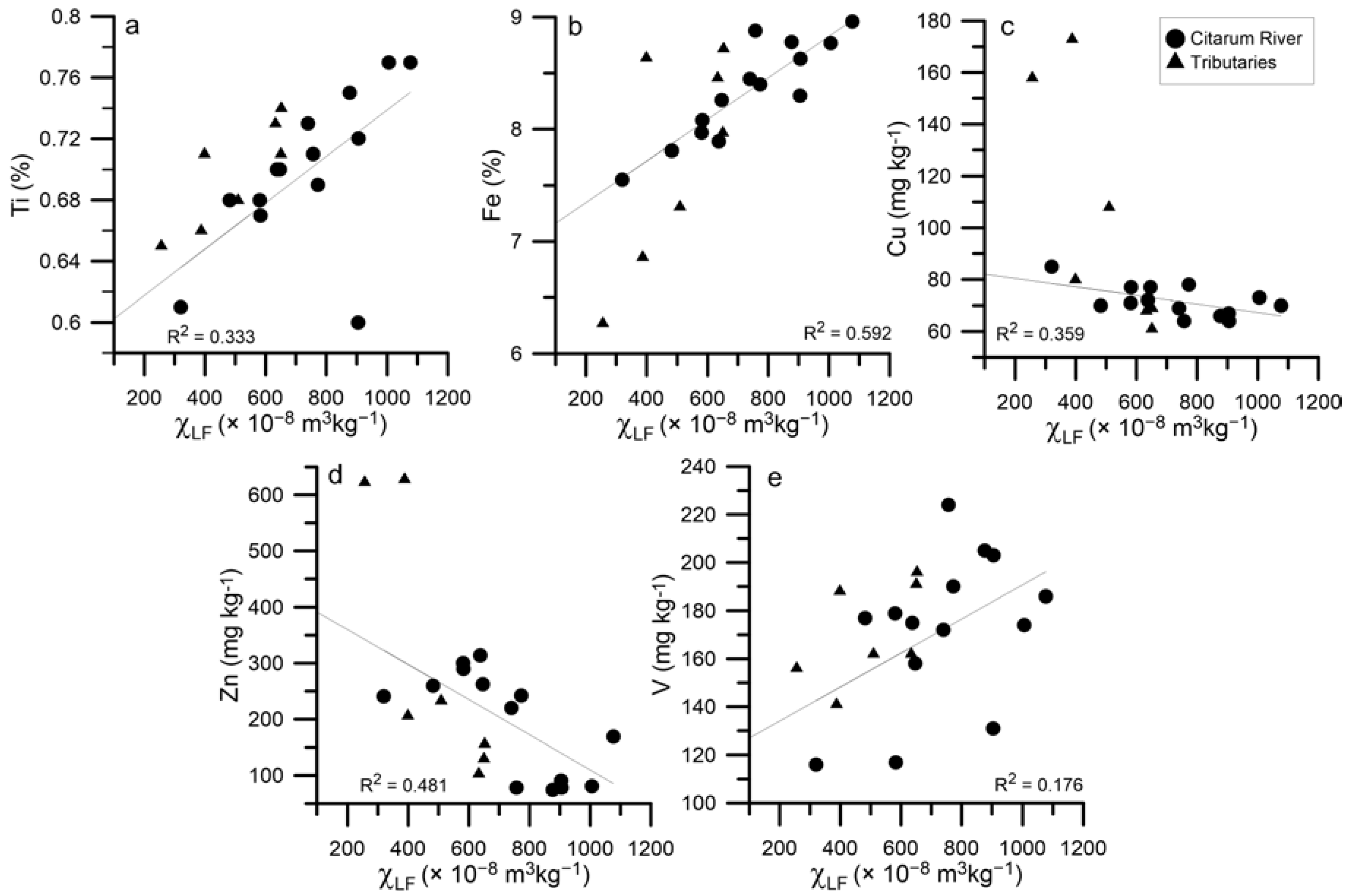
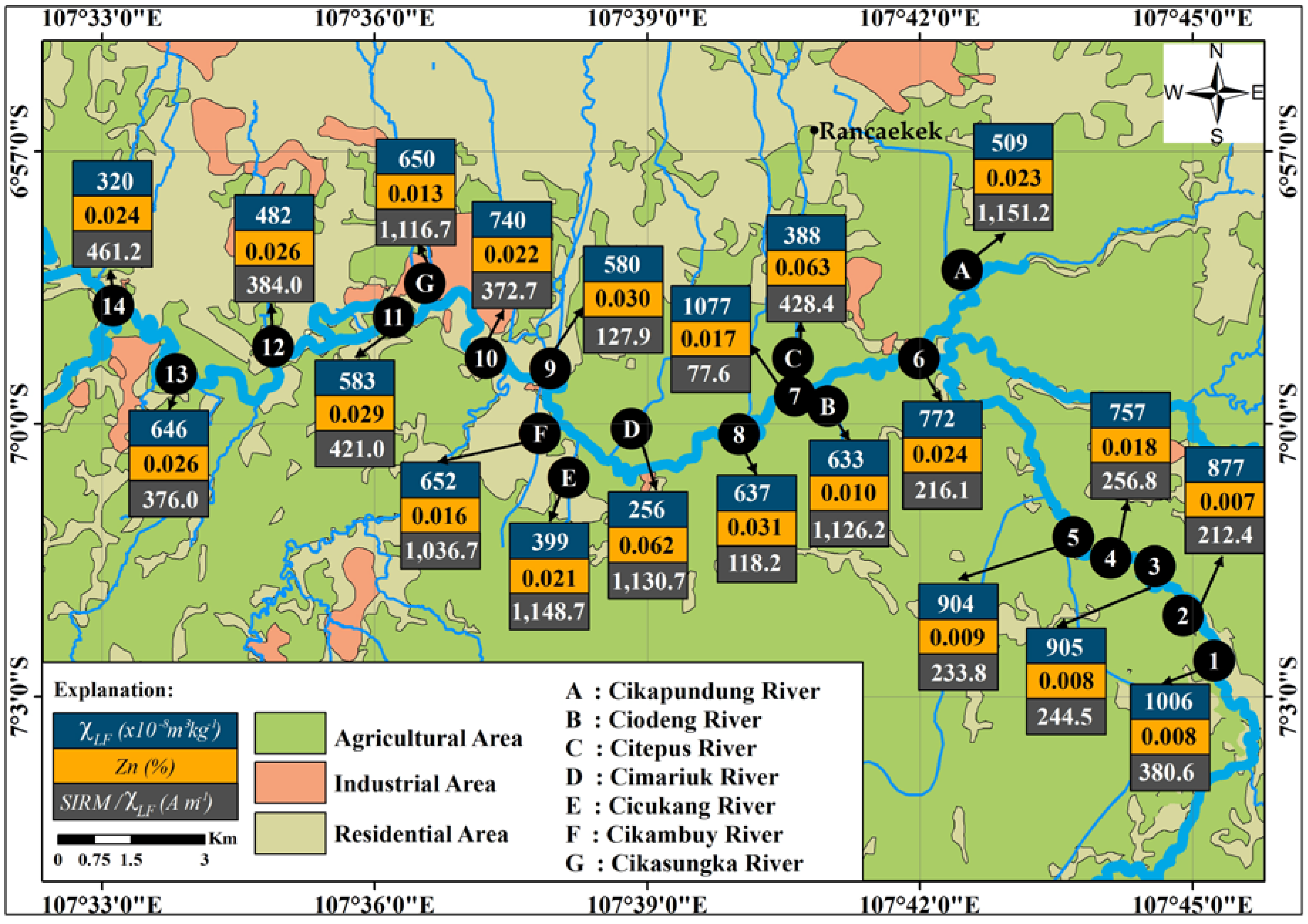
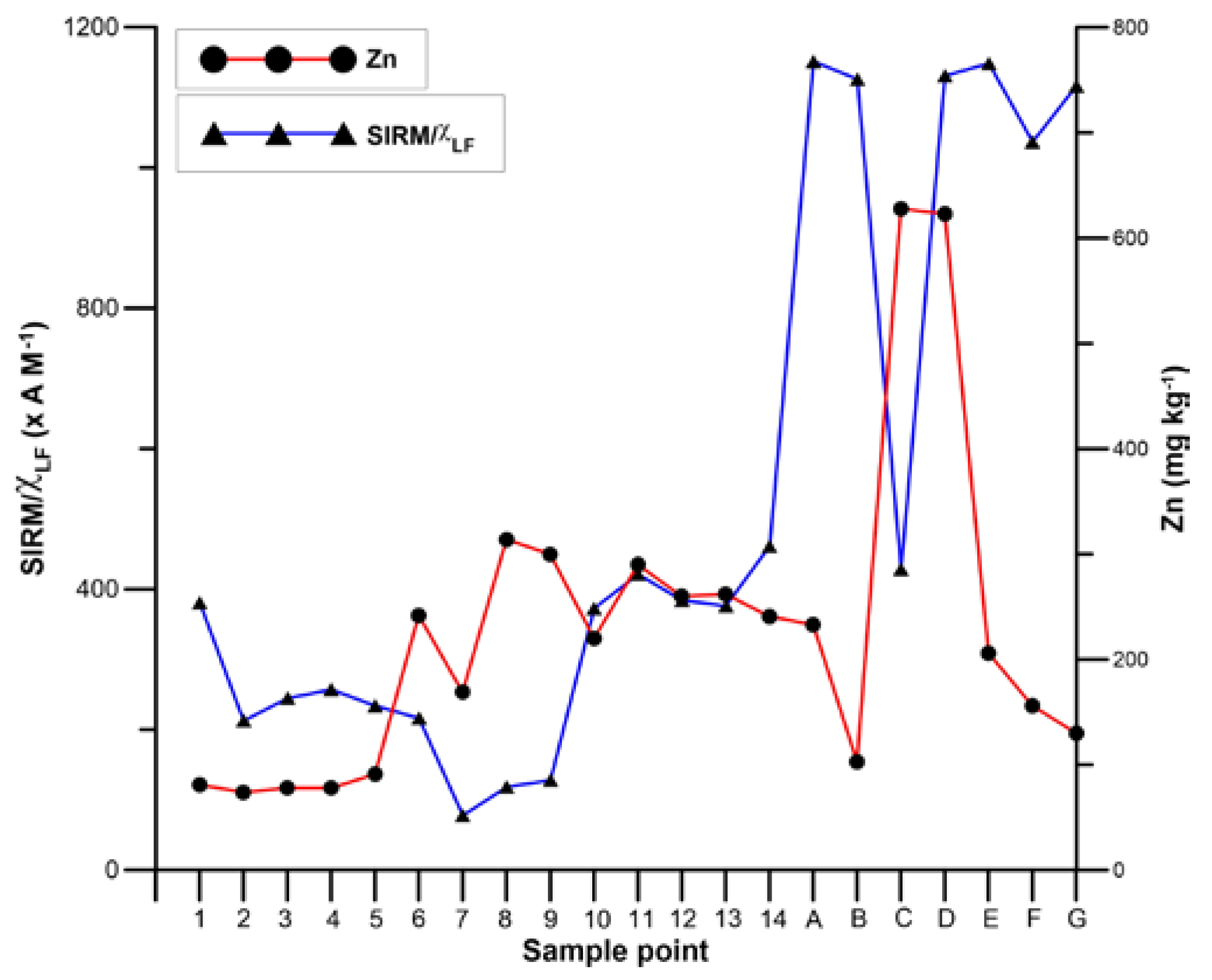
| Sample | Magnetic Parameters | Component | |||||||||
|---|---|---|---|---|---|---|---|---|---|---|---|
| χLF (× 10−8 m3·kg−1) | χFD (%) | SIRM (× 10−6Am2·kg−1) | %magnetite (‰) | SIRM/χLF (Am−1) | Ti (%) | Fe (%) | Cu (mg·kg−1) | Zn (mg·kg−1) | V (mg·kg−1) | ||
| Citarum River | |||||||||||
| 1 | 1005.8 | 3.3 | 3828.3 | 4.16 | 380.6 | 0.77 ± 0.02 | 8.77 ± 0.07 | 73 ± 16 | 81 ± 14 | 174 ± 74 | |
| 2 | 876.5 | 3.5 | 1861.6 | 2.02 | 212.4 | 0.75 ± 0.02 | 8.78 ± 0.07 | 66 ± 16 | 74 ± 14 | 205 ± 69 | |
| 3 | 905.3 | 4.5 | 2213.0 | 2.41 | 244.5 | 0.72 ± 0.02 | 8.63 ± 0.07 | 64 ± 15 | 78 ± 13 | 203 ± 7 | |
| 4 | 757.0 | 5.2 | 1943.8 | 2.11 | 256.8 | 0.71 ± 0.02 | 8.88 ± 0.07 | 64 ± 16 | 78 ± 19 | 224 ± 69 | |
| 5 | 904.1 | 4.1 | 2113.4 | 2.30 | 233.8 | 0.60 ± 0.02 | 8.30 ± 0.07 | 67± 15 | 91 ± 1.4 | 131 ± 65 | |
| 6 | 772.3 | 3.6 | 1668.8 | 1.81 | 216.1 | 0.69 ± 0.02 | 8.40 ± 0.07 | 78 ± 16 | 242 ± 2.1 | 190 ± 64 | |
| 7 | 1076.6 | 3.1 | 835.7 | 0.91 | 77.6 | 0.77 ± 0.02 | 8.96 ± 0.07 | 70 ± 17 | 169 ± 19 | 186 ± 68 | |
| 8 | 637.1 | 3.1 | 753.4 | 0.82 | 118.2 | 0.70 ± 0.02 | 7.89 ± 0.07 | 72 ± 15 | 314 ± 23 | 175 ± 66 | |
| 9 | 580.4 | 4.6 | 742.4 | 0.81 | 127.9 | 0.68 ± 0.02 | 7.97 ± 0.07 | 71 ± 16 | 300 ± 24 | 179 ± 63 | |
| 10 | 739.6 | 3.7 | 2756.4 | 3.00 | 372.7 | 0.73 ± 0.02 | 8.45 ± 0.07 | 69 ± 16 | 220 ± 21 | 172 ± 65 | |
| 11 | 582.5 | 4.2 | 2452.5 | 2.67 | 421.0 | 0.67 ± 0.02 | 8.08 ± 0.07 | 77 ± 16 | 290 ± 23 | 117 ± 64 | |
| 12 | 482.2 | 4.5 | 1856.0 | 2.02 | 384.0 | 0.68 ± 0.02 | 7.81 ± 0.07 | 70 ± 15 | 260 ± 22 | 177 ± 65 | |
| 13 | 646.4 | 3.4 | 2430.4 | 2.64 | 376.0 | 0.70 ± 0.02 | 8.26 ± 0.07 | 77 ± 16 | 262 ± 22 | 158 ± 63 | |
| 14 | 319.6 | 6.1 | 1477.1 | 1.61 | 461.2 | 0.61 ± 0.02 | 7.55 ± 0.07 | 85 ± 16 | 241 ± 21 | 116 ± 61 | |
| Tributaries | |||||||||||
| A | 509.2 | 3.3 | 5861.7 | 6.37 | 1151.2 | 0.68 ± 0.02 | 7.31 ± 0.07 | 108 ± 17 | 233 ± 21 | 162 ± 66 | |
| B | 632.9 | 4.2 | 7127.9 | 7.75 | 1126.2 | 0.73 ± 0.02 | 8.46 ± 0.07 | 68 ± 15 | 103 ± 15 | 162 ± 66 | |
| C | 387.5 | 4.3 | 1659.9 | 1.80 | 428.4 | 0.66 ± 0.02 | 6.86 ± 0.07 | 173 ± 20 | 628 ± 31 | 141 ± 66 | |
| D | 256.0 | 2.1 | 2894.6 | 3.15 | 1130.7 | 0.65 ± 0.02 | 6.27 ± 0.07 | 158 ± 23 | 623 ± 36 | 156 ± 66 | |
| E | 398.9 | 3.4 | 4582.3 | 4.98 | 1148.7 | 0.71 ± 0.02 | 8.64 ± 0.07 | 80 ± 17 | 206 ± 20 | 188 ± 65 | |
| F | 652.4 | 3.5 | 6762.9 | 7.35 | 1036.7 | 0.74 ± 0.02 | 8.72 ± 0.06 | 69 ± 16 | 156 ± 18 | 196 ± 66 | |
| G | 650.2 | 3.4 | 7260.6 | 7.89 | 1116.7 | 0.71 ± 0.02 | 7.97 ± 0.07 | 61 ± 15 | 130 ± 16 | 191 ± 62 | |
© 2017 by the authors. Licensee MDPI, Basel, Switzerland. This article is an open access article distributed under the terms and conditions of the Creative Commons Attribution (CC BY) license (http://creativecommons.org/licenses/by/4.0/).
Share and Cite
Sudarningsih, S.; Bijaksana, S.; Ramdani, R.; Hafidz, A.; Pratama, A.; Widodo, W.; Iskandar, I.; Dahrin, D.; Jannatul Fajar, S.; Agus Santoso, N. Variations in the Concentration of Magnetic Minerals and Heavy Metals in Suspended Sediments from Citarum River and Its Tributaries, West Java, Indonesia. Geosciences 2017, 7, 66. https://doi.org/10.3390/geosciences7030066
Sudarningsih S, Bijaksana S, Ramdani R, Hafidz A, Pratama A, Widodo W, Iskandar I, Dahrin D, Jannatul Fajar S, Agus Santoso N. Variations in the Concentration of Magnetic Minerals and Heavy Metals in Suspended Sediments from Citarum River and Its Tributaries, West Java, Indonesia. Geosciences. 2017; 7(3):66. https://doi.org/10.3390/geosciences7030066
Chicago/Turabian StyleSudarningsih, Sudarningsih, Satria Bijaksana, Rizky Ramdani, Abd Hafidz, Aditya Pratama, Widodo Widodo, Irwan Iskandar, Darharta Dahrin, Silvia Jannatul Fajar, and Nono Agus Santoso. 2017. "Variations in the Concentration of Magnetic Minerals and Heavy Metals in Suspended Sediments from Citarum River and Its Tributaries, West Java, Indonesia" Geosciences 7, no. 3: 66. https://doi.org/10.3390/geosciences7030066
APA StyleSudarningsih, S., Bijaksana, S., Ramdani, R., Hafidz, A., Pratama, A., Widodo, W., Iskandar, I., Dahrin, D., Jannatul Fajar, S., & Agus Santoso, N. (2017). Variations in the Concentration of Magnetic Minerals and Heavy Metals in Suspended Sediments from Citarum River and Its Tributaries, West Java, Indonesia. Geosciences, 7(3), 66. https://doi.org/10.3390/geosciences7030066






